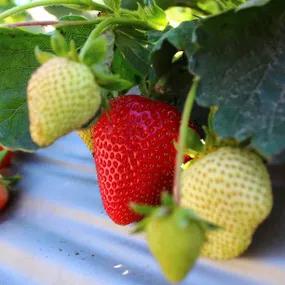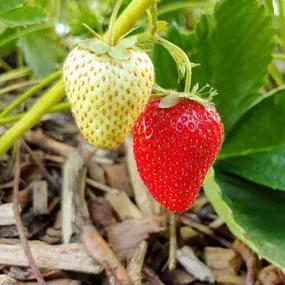Buying Strawberry Plants Online:
Order Potted Strawberry Bushes Now For August Delivery
Pre-Order Bareroot Strawberries For 2025/26 Winter Season
Your strawberry plants are grown from shoots called runners that were produced by adult plants during the previous summer. These are encouraged to take root securely and allowed to grow before being lifted and sent to you.
Strawberries need sun; plenty of other soft fruit can do well enough in the shade, but not these beauties. At the absolute minimum, they need 6 hours per day of spring and summer sun, but 10 is better.
The most shade-tolerant strawberries are alpine types with small fruit, which are more of a tasty novelty than a real producer.
It is common to grow strawberries through plastic mulch mats with a grid of holes burned through them; burning the holes makes their edges fairly strong and durable, whereas cutting them leaves the edges of the holes frayed and quite weak, reducing the useful lifespan of the sheet.
Remember that strawberry plants all look pretty similar, and they clone themselves prolifically using runners that can easily travel a metre or two away from the mother plant.
If you plant different varieties in rows next to each other, they will try to mix themselves up unless you stay on top of tidying them, therefore keeping different strawberry cultivars in well separated beds or rows is easiest.
We also sell a large range of other Soft Fruit Plants.
Your mail order strawberry plants are delivered by next working day courier.
If there is anything wrong with your plants when they arrive, Contact Us within 5 working days, and our friendly support team will sort it out.
All bareroot plants are covered by our Refund Guarantee, so you can give them a whirl with complete confidence.
How do you grow strawberries?
Strawberries can be grown in the ground, and they do well in pots or even hanging baskets if you keep them well watered.
Grow your strawberries in well-drained soil or potting mix enriched with compost or organic material. The soil should be slightly acidic.
Traditionally, you mulch the soil around the strawberries with a thick layering of straw or hay, helping to keep the fruit off the ground and protecting it from pests such as slugs and snails.
These days, many home gardeners will grow strawberries through a plastic mulch mat. It's best to burn, rather than cut, the planting holes, which helps to prevent the edges from fraying, which makes the plastic last longer.
When planting your strawberries, ensure that the crown sits just above the soil.
- Keep your plants well-watered right throughout the growing season.
- Apply a balanced fertiliser formulated for fruiting plants at least once or twice a year during spring and summer.
- Remove the runners regularly to keep the plants under control.
- You can plant the runners in other parts of your garden or give them away.
Managing Strawberry Runners
- When your plants make runners of their own, you can select the best one or two of them and plant them next to your older plants to make new bushes.
- Strawberries fruit quite well in their first year, very well in their second year, about the same in their third year. After that, their crops decline and they often pick up diseases.
- For this reason, we recommend that you arrange your plants in rows with space on one or both sides and keep track of their age. Each year, take at least one runner from each plant and make a new row with them. Like this, you will be sure to always have a row of second year plants that will do you proud.
- After the 3rd or 4th year, it is best to remove and burn your old plants. You will have so many new ones coming up from runners that there is no point keeping old plants!




.webp)
.webp)

 2.webp)
